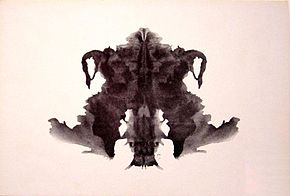| Ink Blot Test | |
|---|---|
 The fourth blot of the Rorschach test | |
| MeSH | D007282 |
An ink blot test is a personality test that involves the evaluation of a subject's response to ambiguous ink blots. This test was published in 1921 by Swiss psychiatrist Hermann Rorschach. The interpretation of people's responses to the Rorschach Inkblot Test was originally based on psychoanalytical theory but investigators have used it in an empirical fashion. When this test is used empirically, the quality of the responses is related to the measurements of personality.[1]
Throughout the 1940s and 1950s the ink blot test was popular among clinical psychologists but quickly lost popularity as critics claimed it to be too subjective. Variations of the ink blot test have since been developed such as the Holtzman Inkblot Test and the Somatic Inkblot Series.[2]
An ink blot test is a general category of projective tests. In projective tests, participants' interpretations of ambiguous stimuli are used to analyze inner thoughts, feelings, and personality traits. In the 19th century, ink blots were used for a game called "Blotto".[3] There are also tests that were developed to be used in clinical, organizational, and human resource departments.[4] These projective tests are often organized in a taxonomy using the categories: Association, Construction, Completion, Arrangement, and Expression.[5]
Herman Rorschach created the first systematic ink blot test of its kind in the early 1920s that interpreted personality characteristics of subjects taking the test.[6] His test was widely popular but also critiqued. After his death, multiple other Ink Blot tests were formed. Some of these new tests include: The Howard Ink Blot Test, Holtzman inkblot technique, and Rorschach II Ink Blot Test.
Under the guidance of Rorschach, Hans Behn-Eschenburg developed 10 similarly designed inkblots to Rorschach's in 1920. Both men died before being able to develop a guide as how to measure, score, and diagnose off of either versions of the ink blot tests.
- ^ Carlson, N. R., & Heth, C. (2010). Psychology--the science of behaviour, fourth Canadian edition [by] Neil R. Carlson, C. Donald Heth. Toronto: Pearson.
- ^ [1], "Rorschach Inkblot Test", Retrieved October 22, 2014.
- ^ Hubbard, K., & Hegarty, P. (2016). Blots and All: A History of the Rorschach Ink Blot Test in Britain. Journal Of The History Of The Behavioral Sciences, 52(2), 146-166.
- ^ Lilienfeld, S. O., Wood, J. M., & Garb, H. N. (2000). The scientific status of projective techniques. Psychological science in the public interest, 1(2), 27-66.
- ^ Lilienfeld, S. O., Wood, J. M., & Garb, H. N. (2000). The scientific status of projective techniques. Psychological science in the public interest, 1(2), 27-66.
- ^ Hubbard, K., & Hegarty, P. (2016). Blots and All: A History of the Rorschach Ink Blot Test in Britain. Journal Of The History Of The Behavioral Sciences, 52(2), 146-166.